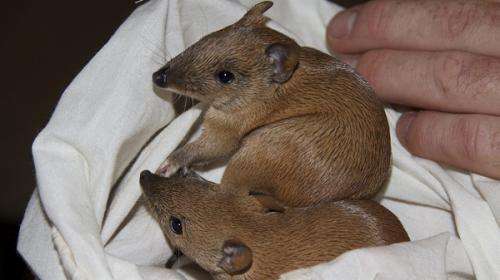“We found the translocated populations grew in size quite rapidly following translocation, which also helps to maintain genetic diversity.”—Dr Ottewell. Credit: Judy Dunlop, Department of Parks and Wildlif
Genetic diversity among translocated populations of golden bandicoots (Isoodon auratus) in the north-west has been assessed by WA researchers to determine their ongoing viability.
The study looked at a large source population of bandicoots on Barrow Island that were translocated to two island sites and a fenced enclosure on the mainland.
Department of Parks and Wildlife (DPaW) research scientist and senior author Kym Ottewell says microsatellites – a genetic marker – were used on translocated bandicoots and their wild-born progeny.
"Microsatellites are highly variable regions of non-functional DNA spread through the genomes of most organisms," she says.
"By sampling a number of these microsatellite regions we are able to build up a unique genetic fingerprint of each individual and then use this information to document whether individuals share the same DNA, or are different, and how different they may be."
Researchers found there was no difference in the number of alleles or heterozygosity of translocated animals at each reintroduction site compared to their source population.
Genetic diversity was maintained in the wild-born bandicoots and Dr Ottewell says there are two possible reasons for this.
"We estimated a sample size of 75 animals would be required to capture 95 per cent of the genetic diversity present at the microsatellite loci we analysed," she says.
"The actual number of animals translocated at three sites was larger [92, 160 and 165 animals], providing some buffer against genetic diversity loss immediately following translocation when mortality rates may be high.
"Golden bandicoots also tend to have a high reproductive rate in the absence of predators and when environmental conditions are good.
"We found the translocated populations grew in size quite rapidly following translocation, which also helps to maintain genetic diversity."
Regular population boosts recommended
But there was a reduction in population size between the founding and wild-born populations.
Bandicoots sourced from Barrow Island had an effective population of less than 1000 compared to the wild-born translocated animals with populations of 100 to 200.
"This reflects the genetic bottlenecking created by the translocation process where only a subset of genotypes are selected for translocation and then only another subset of these may survive through the initial establishment phase when mortality may be high," Dr Ottewell says.
"While we found the raw number of alleles or heterozygosity of the populations does not change, we could detect a difference in the genetic composition of the resulting wild-born populations that reflected this bottlenecking process.
"To counter the loss of diversity, we suggest population supplementation at regular intervals to replenish genetic diversity and prevent inbreeding."
More information: Kym Ottewell, Judy Dunlop, Neil Thomas, Keith Morris, David Coates, Margaret Byrne, "Evaluating success of translocations in maintaining genetic diversity in a threatened mammal," Biological Conservation, Volume 171, March 2014, Pages 209-219, ISSN 0006-3207, dx.doi.org/10.1016/j.biocon.2014.01.012.
Journal information: Biological Conservation
Provided by Science Network WA






















